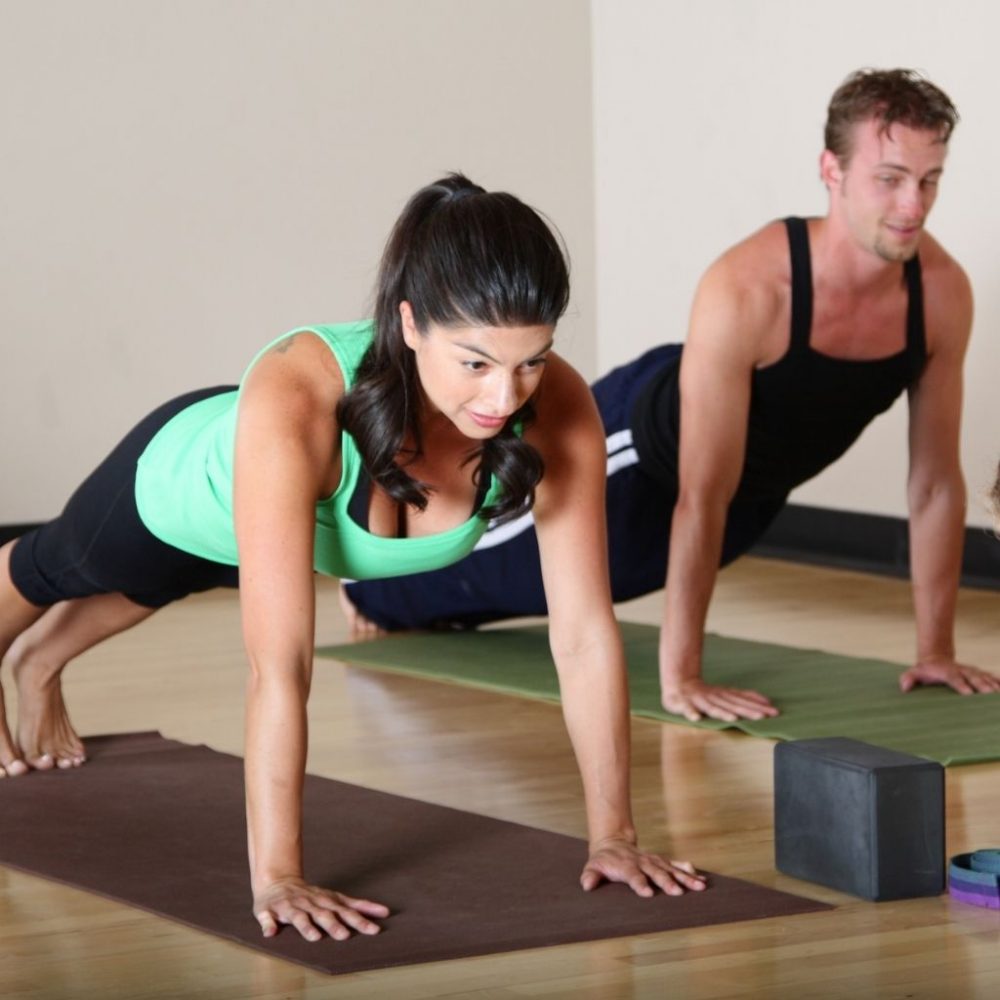Is Yoga More Effective Than Cardio & Going to the Gym?
People nowadays are much more aware that having a balanced lifestyle and balanced diet can help them stay healthy and young.
This also implies doing regular exercises for maintaining muscle strength and being fit and lean.

As yoga’s popularity has been growing, the discussions about which is more effective have been rising.
But, when you take things from the bird’s perspective, then there’s one clear answer.
Neither Yoga nor cardiovascular exercises at the gym are more effective in losing weight. Your weight loss strictly depends on your calorie intake and your metabolic rate. Yoga and cardiovascular gym activities can increase your BMR, but the rate at which they do depends on the intensity and the number of times you practice.
In the end, what matters is what you enjoy doing the most to build a consistent practice.
This article explains the difference you may find between these two exercise types and what else you have to gain from practicing them.
Read on!

What’s the difference between yoga and gym?
Yoga is all about achieving unity between the body, mind, and soul, even though it can be regarded as physical activity, the regular practice goes way beyond that. On the other hand, gym activities involve using equipment and following routines that combine cardiovascular exercises to lose weight and tone your muscles.
Combining the two would be a much-preferred recommendation in a perfect world as you can benefit from both.
Bear in mind, though, that yoga can deliver much of the physical benefits that gym does, so it is always a good idea to consider the following advantages that yoga offers:
Yoga Detoxifies Your Body
When speaking about detoxification, we usually imagine a fasting technique or implementing natural, fresh food in our diet. That is more or less the case.
However, doing yoga means cleansing the body from stored fat, negative energy, and mental obstacles.
It activates the whole body, and when used together with meditation, it strengthens your cognitive and mental capacity.
Anyone Can Do Yoga
Anyone can do yoga at any age and at any time.
Even if you suffer from certain health conditions, you can still do yoga.
For cardiovascular diseases, diabetes, and chronic back and neck pain, yoga can significantly lower the symptoms and maintain your quality of life.
It is efficient in regulating metabolism and preserving your vitality.
Unfortunately, one can’t make the same claims regarding the gym, particularly if you struggle with chronic diseases.
Yoga Helps You Boost Focus and Concentration
As mentioned before, while doing yoga, you practically reconnect with yourself, allowing free energy flow, improved breathing, and mental release.
The tension you’ve been feeling during the day gets filtered, so you start thinking clearly, considering things from another perspective.
Gym exercises help you release the accumulated energy, but it does nothing to perform mentally better.
Yoga Helps You Relax
Doing yoga will not burn you out, while some strenuous workouts are likely to make you feel exhausted.
After any yoga session, you feel energized and much more relaxed, as meditation, postures, and breathing techniques help you find your inner balance.
No Equipment Needed
The only thing you need to do yoga is a mat.
You can do it anywhere you like, provided the place offers peace to reconnect with yourself mentally.
Working out in a gym means spending time to get to the gym and spending money on monthly fees.

Yoga or gym, which one is better for weight gain (building muscle)?
When discussing muscle growth and weight gain through targeted muscle exercises, the gym, i.e., weight lifting, is the most common go-to place.
Doing regular gym exercises combined with protein-based food seems to be the formula for fast muscle growth and good weight gain.
When considering the physical aspect of the exercises, then yoga delivers flexibility, muscle strength, and tone. You can hardly ever see a guru or a yoga practitioner being even slightly overweight.
The only weight resistance is your weight, so it isn’t very likely that you can have the same muscle growth as weight lifting can provide.
In essence, weight (muscle) gain is achieved by adding more calories to your daily intake and practicing strength training exercises.
However, a 2015 study in a 12-week Hatha yoga intervention has revealed interesting results.
Namely, both men and women had increased muscle strength, flexibility, and endurance from the Chair and Warrior poses.
In addition, yoga styles like Ashtanga and Vinyasa contribute towards muscle strength and muscle gain.
These styles incorporate movements that use a person’s weight as resistance, isometric holds, and push-up variations.
Those people who focus on weight gain are recommended to practice poses that activate large muscle groups and commit to yoga more than four times a week.
Differences Between Men and Women
Even with proper training and instruction, both men and women can efficiently gain muscle mass and become lean. Genetically, men have less fat and more muscle mass, which means they need more calories to maintain their weight.
This means that men are likely to benefit from more strenuous gym exercises that target specific muscle groups. At the same time, women are more likely to maintain weight and become lean by doing yoga.
In addition, extreme muscle gain looks and ‘feels’ right when it comes to men. However, women strive to gain weight (or lean muscles) but at the same time maintain their feminine appearance and looks.
Yoga will never deliver excessive muscle mass gain, so women can benefit much more from yoga even if they increase their weight.
How Does Food Affect Weight Gain?
Food has an immense impact on your weight gain. Many people believe; even that there’s nothing easier to gain weight than increasing your caloric intake. Unfortunately, that’s far from true.
Uncontrolled caloric intake means overeating and, most likely unhealthy and unbalanced food. The body’s digestive mechanism will struggle to process the food and will start storing it as fats.
Furthermore, if the food is fatty or sugary, it won’t be burnt as fuel to assist your weight management.
So what kind of food do experts recommend to gain weight?
Protein shakes, protein bars, nuts, rice, bananas, red meat, oily fish, healthy cereals, dark chocolate, and milk smoothies are the most common food recommendations.
For optimal and targeted weight (muscle) gain, it is recommended to take protein-rich food (grains, dairy products, peanut butter, roots, honey, seeds, etc.) an hour or two before doing exercises or yoga and a similar meal about an hour after the practice.
Yoga Vs. Gym to reduce belly fat
Reducing your belly fat comes down to lowering your calorie intake and raising your metabolism; both yoga and gym can help you increase your metabolic rate, assuming you are doing cardiovascular exercises.
If you intend to lose weight and prefer going to the gym, fill your routine with intensive cardiovascular activities; if yoga is your go-to pick, choose a style with high intensity like Ashtanga, Hot yoga, or Bikram.
Belly fat is the number one enemy for many people who struggle to lose weight and become lean.
Women store a higher amount of fat around their bellies than men, and it is harder for them to reduce belly fat.
Regardless, gym and yoga can be great to increase your metabolic rate (and reduce belly fat); what matters most is how often you practice and how intense your workout is.

The importance of metabolic rate to lose or gain weight
Basal metabolic rate (BMR) refers to the number of calories your body needs to perform the most basic body functions (breathing, moving, eating).
An individual’s BMR is as unique as our DNA. This means that if one person needs 1200 calories per day for maintaining life-sustaining body functions, another one might need 2000.
Also, there’s a common belief that the more calories we burn, the easier it will be to lose weight. While that might be mathematically correct, in reality, things aren’t so black and white.
In essence, the metabolic rate is determined by numerous factors such as our gender, age, physical activity, muscle-to-fat ratio, and hormone balance.
The food type you eat determines your BMR
The energy that the body burns at a given time describes our metabolism. This involves processes that break down nutrients from the food we eat and processes that build, maintain, and repair our bodies.
But not all food we eat is created equal, so understanding what food burns faster without being stored into fat is crucial to lose, maintain or even gain weight.
Proteins
The number one food type our body needs to function appropriately is proteins. Proteins are essential for most metabolic processes. They create our muscles, so they are the most needed food that our body needs.
Proteins are formed of amino acids that take part in DNA cell divisions, so they are the crucial nutrients for staying healthy and vital. Our lean muscle mass is composed of proteins, so the leaner you are, the faster your metabolic rate you’ll have.
In other words, when eating proteins, our body uses these macronutrients to support itself, so they are rarely stored as fat.
Carbohydrates
Carbohydrates are commonly referred to as primary energy sources.
These are divided into two groups, starches and sugars. Starches are complex, nutritious, and contain fibers, i.e., they make us feel energized and full.
Fibers are considered natural cleansers, prevent fat storage, and protect our bodies against gastrointestinal diseases.
Unlike starches, sugars are simple, with low nutritional value, and don’t provide much benefit. Sugars are rarely natural, and when consumed, they cause a quick insulin spike.
As insulin is a hormone that stores fat, it signals the body to pull energy from the bloodstream, making you feel hungry, and crave more food.
This is the number one cause of obesity worldwide, as more and more people tend to eat refined food that increases sugar levels.
Fats
Fats are essential energy providers, and they release more energy than carbohydrates and proteins. However, there are three types of fats, each of which affects the human body differently.
- Unsaturated fats: The so-called ‘good fats’ found in fish products and some plants. These are the primary sources of Omega acids which are crucial for maintaining our immune system. And even though they are fats, they are rarely stored as human fat.
- Saturated fats: These fats are found in red meat, cream, cheese, butter, and lard. When stored in large amounts, they can have adverse effects on the human body and cause cancer, diabetes, or heart failure.
- Trans fats: The notorious ‘bad fats’ found in processed food and margarine. They have meager nutritional value and are easily stored in fat.
The information above leads to the conclusion that counting calories is just a refocus from the essential point. Namely, depending on your body type, hormonal activity, and physical activity, you can increase your metabolic rate and burn out more calories without even counting.
Wanna know more? 👉 Here Is Healthy Eating More Important than Exercise for Weight Loss?
Conclusion
Considering everything we have said so far, we can conclude that yoga is far more effective than going to the gym.
This is particularly true if your goal is to activate your body, mentally relax, and keep lean.
When doing yoga, you activate not only specific muscles but almost all body processes. This is crucial for burning calories, gaining muscle strength and endurance, and keeping lean.
Plus, yoga makes you feel energized and relaxed simultaneously, a unique feature that any other physical activity can’t offer.
Read also:

